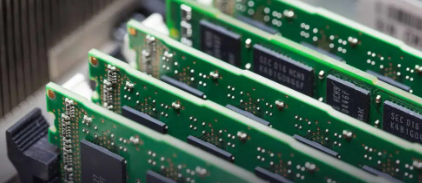What is a memory chip? What are the types of memory chips?
Memory chips are the main components used for storage In the realm of computing and digital devices, and play a very important role in the entire integrated circuit market.

These chips serve as the foundation upon which our digital world operates, facilitating the storage and retrieval of information in devices ranging from smartphones and laptops to complex servers and embedded systems.
What is a memory chip?A memory chip, fundamentally an integrated circuit (IC), is a crucial electronic component designed to store, retrieve, and manage data within a digital device. These chips come in various types and configurations, each tailored to serve specific purposes within electronic systems.
What are the types of memory chips?RAM (Random Access Memory): One of the most common types of memory chips, RAM is volatile memory used by computers to temporarily store data that the CPU needs quick access to during operation. It enables swift read and write operations, facilitating multitasking and overall system performance.
ROM (Read-Only Memory): Unlike RAM, ROM is non-volatile memory, meaning it retains data even when the power is turned off. ROM is commonly used to store firmware and permanent instructions essential for booting up devices and initializing hardware components.
Flash Memory: This non-volatile memory type finds its application in devices like USB drives, Solid State Drives (SSDs), memory cards, and embedded systems. Flash memory allows for both reading and writing operations, making it suitable for storing files, applications, and operating systems.
EEPROM (Electrically Erasable Programmable Read-Only Memory): EEPROM combines the qualities of both volatile and non-volatile memory. It’s rewritable and often used in smaller capacities to store configuration settings and small amounts of essential data.
What are the applications of memory chips?The ubiquity of memory chips spans across an extensive array of applications and devices, playing a pivotal role in their functionality:
• Computers and Laptops: RAM enables quick access to data during computations, while ROM stores firmware and BIOS instructions essential for system startup.
• Smartphones and Tablets: Memory chips in these devices handle data storage for applications, media files, and the operating system, ensuring smooth multitasking and user experience.
• Digital Cameras and Camcorders: These devices utilize memory chips to store photos, videos, and settings, allowing users to capture and retain precious moments.
• Embedded Systems and IoT Devices: Memory chips facilitate the functioning of embedded systems and IoT devices, managing data crucial for their operations in various industries like healthcare, automotive, and home automation.
How to make a computer chip?The creation of a memory chip involves intricate processes conducted in specialized semiconductor fabrication plants. The process can be summarized in several key steps:
Design and Layout: Engineers meticulously design the chip’s layout, determining the arrangement and connections of transistors and circuits.
Lithography: A crucial step where the chip’s design is imprinted onto a silicon wafer using photolithography techniques.
Etching and Doping: Unwanted portions of the silicon wafer are removed, and specific regions are doped with materials to alter their conductivity and create the desired electronic components.
Layering: Multiple layers of conductive and insulating materials are deposited onto the wafer to form intricate circuitry.
Testing and Packaging: The fabricated chips undergo rigorous testing to ensure functionality and quality. Once validated, they are packaged into final products for integration into various devices.
What is the difference between a logic chip and memory chip?While both logic and memory chips are essential components of electronic systems, they serve distinct functions:
Logic Chip:
A logic chip is designed to perform computational tasks, execute instructions, and manage the flow of data within a digital device. These chips contain integrated circuits that implement logical operations, arithmetic calculations, and control functions. They are the brains of a system, carrying out operations based on instructions received from software or firmware.
Examples of logic chips include Central Processing Units (CPUs), Graphics Processing Units (GPUs), microcontrollers, and Application-Specific Integrated Circuits (ASICs). CPUs, for instance, process data, perform calculations, and execute instructions, while GPUs specialize in handling graphics-related tasks.
Memory Chip:
In contrast, a memory chip is specifically dedicated to storing and retrieving data. These chips don’t perform computational or logical operations but instead focus on holding information temporarily or permanently within a system. Memory chips are responsible for enabling the storage and retrieval of data for various purposes, such as program execution, data manipulation, or long-term storage.
Types of memory chips include Random Access Memory (RAM), Read-Only Memory (ROM), Flash Memory, and Electrically Erasable Programmable Read-Only Memory (EEPROM). RAM, for example, stores data temporarily while the system is running, allowing quick access for the CPU to carry out operations. ROM holds essential instructions and data that remain intact even when the power is turned off. Flash memory is used for non-volatile storage in devices like USB drives and SSDs, while EEPROM allows for rewritable non-volatile storage in smaller capacities.
How long does a memory chip last?
The longevity of memory chips varies based on usage, quality, and environmental factors. Under normal operating conditions, these chips can last for many years, potentially even decades. However, excessive usage, high temperatures, or voltage fluctuations may impact their lifespan.
在线留言询价
- 一周热料
- 紧缺物料秒杀
| 型号 | 品牌 | 询价 |
|---|---|---|
| CDZVT2R20B | ROHM Semiconductor | |
| TL431ACLPR | Texas Instruments | |
| BD71847AMWV-E2 | ROHM Semiconductor | |
| MC33074DR2G | onsemi | |
| RB751G-40T2R | ROHM Semiconductor |
| 型号 | 品牌 | 抢购 |
|---|---|---|
| TPS63050YFFR | Texas Instruments | |
| BP3621 | ROHM Semiconductor | |
| BU33JA2MNVX-CTL | ROHM Semiconductor | |
| IPZ40N04S5L4R8ATMA1 | Infineon Technologies | |
| STM32F429IGT6 | STMicroelectronics | |
| ESR03EZPJ151 | ROHM Semiconductor |
- 周排行榜
- 月排行榜
AMEYA360公众号二维码
识别二维码,即可关注























